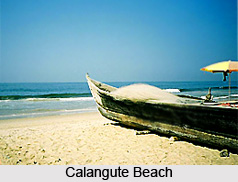 Calangute Beach is the prominent sea beach of North Goa. This sea beach offers the open air market in the day time and the night becomes the dais of party time with dazzling lights.
Calangute Beach is the prominent sea beach of North Goa. This sea beach offers the open air market in the day time and the night becomes the dais of party time with dazzling lights.
Cobalt blue waters gurgling along the sandy beach and the sky bending at the horizon to touch the waves define a quintessential sea beach. Yet what puts Calangute beach ahead in the league is its idyllic setting. Amongst the rolling waves, Calangute is the ultimate destination to try out water sports yet the beach has a calming effect. As per records, the Calangute beach was discovered in 1960 by the hippies. Since then it has grown in popularity; thus making it one of the most cherished vacation spots in Goa.
The beach derives its name probably from the distorted version of the local word, "Koli-gutti" which means the land of fishermen. The origin of its name is also associated with the word, Kalyangutti, meaning a village of art or Konvallo-ghott (a place with coconut trees). It was the Portuguese who distorted the local name and referred as Calangute. Originally a village, Calangute is flanked by Arpora-Nagoa, Saligao and Candolim villages.
 The main attraction of Calangute is its beach, undoubtedly. However, besides the beach, tourists can also explore the local market. It is the perfect place to shop for bags, beachwear, chappals, sweets and dry fruits. Goa is known for its cashew nuts and the local markets are filled with cashew nut stores.
The main attraction of Calangute is its beach, undoubtedly. However, besides the beach, tourists can also explore the local market. It is the perfect place to shop for bags, beachwear, chappals, sweets and dry fruits. Goa is known for its cashew nuts and the local markets are filled with cashew nut stores.
Calangute beach throbs with life throughout the day and even through wee hours of the night. Water sports, like, parasailing, motor boats, jet-skiing, etc are popular with the tourists. Calangute beach is flooded with wooden beach rest chairs where one can relax with the help of massage after a quick dip in the sea. Equipments for swimming are also available here.
Another attraction of the Calangute beach is the food shack. What better way to enjoy the mesmerising sunset that sitting on the rest chair, enjoying a cool drink and staring into the setting sun. As evening falls, one can witness than entire new facet of the beach.
The food shacks are decked up with lights. The tables have earthen lamps that add on to the charm of the sea. With cool breeze and light music playing in the background, these are perfect places to relax after a long day.



















